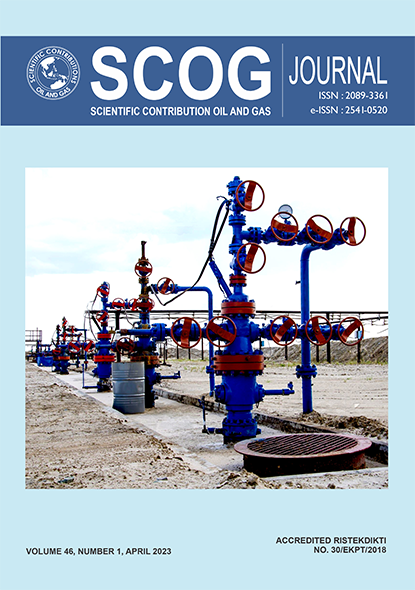PRODUCTION FORECASTING USING ARPS DECLINE CURVE MODEL WITH THE EFFECT OF ARTIFICIAL LIFT INSTALLATION
DOI:
https://doi.org/10.29017/SCOG.46.1.1310Keywords:
Production forecasting, Least-square method, Arps’ Model, Estimated Ultimate RecoveryAbstract
There are many methods for predicting the production performance of oil wells, using the simplest method by looking at the declining trend of production, such as Decline Curve Analysis (DCA), Material Balanced, or using reservoir simulations. Each of these methods has its advantages and disadvantages. The DCA method, the Arps method, is often used in production forecast analysis to predict production performance and estimate remaining reserves. However, the limitation of this method is that if the production system changes, the trend of decline will also change. At the same time, the application in the field of taking the trend of decreasing production does not pay attention to changes in the production system. This study aims to see that changes in the well production system will affect the downward trend of well production, estimated ultimate recovery (EUR) value, and well lifetime. To see the effect of these changes, the initial data tested used the results of reservoir simulations and field data. From the evaluation results, it is found that if the production system changes during the production time, for example, from changing natural flow using artificial lifting assistance, the trend taken from the production profile will follow the behaviour of the reservoir if the trend is taken in the last system from the production profile, not from the start of production. If the downward trend is taken without regard to the changing system, then the prediction results will not be appropriate
References
Arps, J.J. 1945. "Analysis of Decline Curves." Trans 160. Houston. pp., 228-247.
Holstein, Edward D. 2007. Volume V: Reservoir Engineering and Petrophysics Petroleum Engineering Hadbook. Society of Petroleum Engineers.
Palash Panja, David A. Wood,. 2022. "Chapter Seven - Production decline curve analysis and reserves forecasting for conventional and unconventional gas reservoirs,." In The Fundamentals and Sustainable Advances in Natural Gas Science and Eng,, pp., 183-215. Cambridge: Gulf Professional Publishing,.
Ram G. Agarwal, David C. Gardner, Stanley W. Kleinstelber, Del D. Fussell. 1999. "Analyzing Well Production Data Using Combined-Type-Curve and Decline-Curve Analysis Concepts." SPE Annual Technical Conference and Exhibition. Society of Petroleum Engineers. pp., 478-486. Available at: https://doi.org/10.2118/57916-PA.
Richard O. Baker, Harvey W. Yarranton, Jerry L. Jensen, 2015. "Reservoir Characterization Methods." In Practical Reservoir Engineering and Characterization, pp., 349-434. Available at: https://doi.org/10.1016/B978-0-12-801811-8.00010-9. Gulf Professional Publishing.
Spivey, J.P., 1986. "A New Algorithm for Hyperbolic Decline Curve Fitting." Petroleum Industry Application of Microcomputer. Silvercreek, Colorado: Society of Petroleum Engineers. Avalaible at: doi: https://doi.org/10.2118/15293-MS.
Weinstein, H. G., J. E. Chappelear, and J. S. Nolen. 1986. "Second Comparative Solution Project: A Three-Phase Coning Study." Journal of Petroleum Technology pp., 345-353.
Arief Rahman, Warto Utomo and Supanca Ade Putri, 2019, "Decline Curve Analysis: Loss Ratio abd Trial Error and X2 Chi-Square Test Methods in the Kais Formation, "R" Field, West Papua." Lembaran Publikasi Minyak dan Gas Bumi Vol.53 No.3. pp., 4-5
Kamal Hamzah, Amega Yasutra, and Dedy Irawan, 2021, "Prediction of Hydraulic Fractured Well Performance using Empirical Correlation and Machine Learning, Scientific Contributions Oil and Gas, 44 (2) pp., 141-152.
Downloads
Published
Issue
Section
License
Copyright (c) 2023 SCIENTIFIC CONTRIBUTIONS OIL AND GAS (SCOG)

This work is licensed under a Creative Commons Attribution 4.0 International License.
Authors are free to Share — copy and redistribute the material in any medium or format for any purpose, even commercially Adapt — remix, transform, and build upon the material for any purpose, even commercially.
The licensor cannot revoke these freedoms as long as you follow the license terms, under the following terms Attribution — You must give appropriate credit , provide a link to the license, and indicate if changes were made . You may do so in any reasonable manner, but not in any way that suggests the licensor endorses you or your use.
No additional restrictions — You may not apply legal terms or technological measures that legally restrict others from doing anything the license permits.














